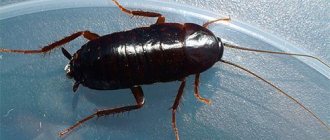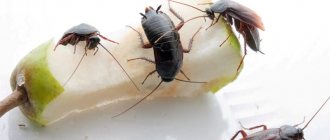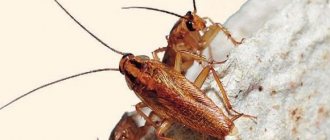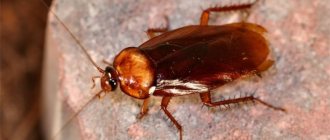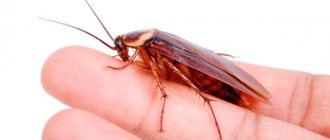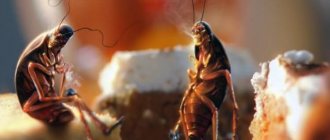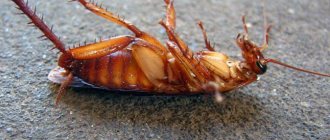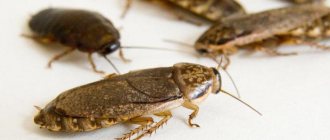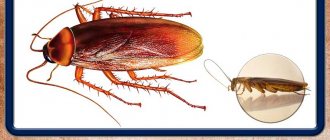Cockroaches (Blattodea) are distributed throughout the world, except in the polar regions. Cockroaches live in dark and damp places. They are typically found in the tropics, where the greatest diversity of species is found. Cockroaches are omnivores and eat a variety of plant and animal products. They are found in a wide variety of biotopes. Cockroaches are one of the most common household pests.
Lapland cockroach (Ectobius lapponicus), male
Etymology
The origin of the word "cockroach" in the Russian and Ukrainian languages is not precisely established; According to Ryasyanen, this word comes from the Chuvash. tar-akan “runaway, fugitive”: Turkic. täz - “to run away.” G. Jacobson suggests that the word comes from the disparaging Turkic “tarkan” - “dignitary”.
The obsolete order name "Blattaria" comes from the Latin "blatta", meaning "light-avoiding insect". The English word "cockroach" is used around 1751 and comes from the Dutch "kakkerlak".
Structure
The body is flat, oval. The eyes are large, there are two ocelli, but in wingless forms they are often atrophied. Sometimes both are absent (often in cave forms). The mouthparts are of the gnawing type, with mandibles, maxillae and lower lip. Cockroaches have strong jaws lined with chitinous teeth. They serve to tear food into pieces and direct them to the entrance to the esophagus. Cockroaches chew food not only with their mouths, but continue to chew even when it is swallowed and is in the stomach: their stomach is equipped with sharp chitinous teeth and very strong muscles.
In those species that have well-developed wings, both pairs bear a large number of longitudinal and many transverse veins; the front pair, narrower, compacted leathery or parchment-like, are called elytra and serve mainly as a protective cover for the wings of the rear pair when the insect is not flying; the rear pair is thin, wider, bears the main load during flight and folds fan-shaped under the elytra at rest. In females, the wings are often shortened or completely reduced. In many species, wings have the appearance of rudiments or are completely absent. Many species of cockroaches can fly. The hind legs are only slightly longer than the front and middle legs; legs of a running type with flattened femurs, mostly armed with spines below; and 5-segmented tarsi.
Temnopteryx sp.
The head is triangular or heart-shaped, flat, with the mouthparts facing downward and almost or completely covered by a large shield-shaped pronotum. The antennae are elongated, multi-segmented, bristle-like. The abdomen is elongated, with soft coverings, consists of 8-10 tergites and 8-9 (males) or 7 (females) sternites (the I tergite of the male and the VI-VIII tergites of the female are often specialized), at the end it usually bears articulated cerci; in males, on the last segment from below there are 1 or 2 unsegmented appendages - the stylus. The external genital apparatus of males is represented by the genital plate. Males often have scent glands on their abdomen. The ovipositor of females in modern species is completely hidden. If a young cockroach loses a leg or antennae, they will grow back with subsequent molts.
Related article Madagascar hissing cockroach (Gromphadorhina portentosa)
do cockroaches have wings night flight
This post has already been read 9792 times!
Hello dear readers. I was thinking - everyone who has encountered cockroaches in their kitchen can be divided into two categories: those who rush to violently crush the nasty insects, and those who run away from the kitchen at the speed of a racing car. I admit honestly - I personally belong to the second category, because the sight of these vile creatures fills me with horror and disgust. And I’m always afraid that the cockroaches, instead of running away, will rise into the air in a crowd and attack. Do you think there is a basis for such fears?
In this article, we will take a general look at the body structure of cockroaches, and I will also tell you about my worst nightmare, because of which I will definitely never fly to Mexico - a flying cockroach. At the same time, we’ll find out whether cockroaches have wings, whether they fly, and why else an arthropod might need wings.
Habitat
Cockroaches live in dark and damp places. They are usually inhabitants of the tropics and subtropics, where the greatest diversity of species, large and small, is found. A small number of species can be found naturally in more northern regions, where they live mostly under the bark of dead trees or lying trunks.
Smoky cockroach (Periplaneta fuliginosa), female with ooteca
Nutrition
Cockroaches are practically omnivores and eat a wide variety of foods of plant and animal origin. They can live for a long time without food (up to three months) and water (one month), and in extreme cases they can eat anything that contains starch (for example, glue for postage stamps, book bindings, paper, etc.). Cockroaches engage in coprophagy, the consumption of fecal pellets. Young cockroaches rarely leave their hiding places and obtain most of their food by eating the fecal pellets of larger individuals. From these they acquire microbial flora, which helps them digest food.
A number of species have adapted to live among insects. For example, the Texas ants (Attaphila fungicola), a tiny (3-5 mm), wingless and blind cockroach, lives in the nests of American leafcutter ants of the genus Atta and feeds on fungi that the ants raise in their homes.
Circulatory system
The circulatory system of the cockroach (Fig. 83), like that of all arthropods, is not closed. Blood directly washes the internal organs and tissues while in the body cavity, transferring nutrients to them and carrying harmful waste products to the excretory organs. Blood does not participate in the transfer of oxygen and carbon dioxide, that is, in respiration. Its movement is ensured by the work of the heart - a longitudinal muscular tube located in the dorsal part above the intestines.
The cockroach's heart, pulsating rhythmically, drives blood to the head end of the body. The backflow of blood is prevented by the heart valves. When the heart expands, blood enters it from the back of the body through its side openings, which are equipped with valves that prevent blood from flowing back. In the body cavity, unlike the heart, blood flows from the front end to the back, and then, entering the heart as a result of its pulsation, it is again directed to the head.
Lifestyle
Cockroaches are found in a wide variety of biotopes, although they are predominantly forest insects. They quickly move in the soil litter, climb plants, and some can swim. Some types of cockroaches are arboreal, others live in caves, and others are aquatic. Most cockroaches are nocturnal, hiding during the day in crevices, dark places, cracks on the soil surface, in rodent burrows, under the bark of stumps and dying trees. Long, movable, thread-like antennae help them navigate in the dark. Winged species of cockroaches can fly to light at night (for example, Blattella asahinai).
In houses they hide in walls, ventilation, cracks between floors, food pantries, in curtains, under furniture and wallpaper and other hard-to-reach places and voids. In the same premises, black and red cockroaches are very rarely found, despite the fact that the Prussian, at least in modern city apartments, is much more widespread.
Eurycotis (Eurycotis decipien)
Cockroaches are very shy. If you suddenly turn on the light in a room, cockroaches of all sizes begin to quickly scatter around the shelters. They run great. The champion is the American cockroach (Periplaneta americana), it reaches speeds of up to 75 cm/sec. The sense of orientation is well developed; in case of danger, the cockroach quickly gets to shelter.
Cockroaches are one of the hardiest insects. Cockroaches have a much more developed ability to resist radiation than vertebrates: the lethal dose of radiation for them is 6-15 times higher than for humans. Some species can live without air for 45 minutes or slow their heart rate. Cockroaches are capable not only of group decision-making, but also of cooperation and competition.
Cockroaches leave behind a chemical trail that other cockroaches use to quickly find their way to sources of water, food or shelter. If a cockroach accidentally falls on its back, it can no longer roll over to its feet and dies of hunger.
How to get rid of cockroaches forever?
After you manage to expel cockroaches from your home, you should make sure that the insects do not return to you. To do this, it is enough to follow a few rules.
- Always store pans, pots and deep bowls upside down, as deep dishes that are stored in a dark place are an ideal place for cockroaches to lay eggs.
- Don't clutter your home. Cockroaches can settle literally in any place that is comfortable for them: in a pile of paper, in things that are rarely worn, in forgotten food, and so on. Therefore, keep clean not only in the house, but also in the attic, and even in the garage.
- Cockroaches do not tolerate the smell of mothballs, so feel free to place mothballs around your apartment so that the insects do not want to crawl to visit you.
- If you have doubts about some holes in the floor or on the wall, simply plug them with an ordinary plastic bag, limiting cockroaches' access to your home.
- Place orange and lemon peels, dried cloves, fresh mint leaves, cucumber peels and cut garlic cloves near the baseboards and doors - cockroaches hate the smell of these products.
- For the first time after baiting cockroaches, leave the lights on in the kitchen or lighting on the cabinets, since insects prefer to sit in the dark.
- Dead cockroaches should either be flushed down the toilet or disposed of in any other reliable way. Under no circumstances should you leave corpses in the apartment, since cockroaches are cannibals, and the remains of their relatives can become excellent food for them.
- After visiting hotels, boarding houses and other temporary accommodation institutions, carefully check your clothes and bags, because one cockroach accidentally brought into the house can lay eggs and cause you a lot of trouble in the future.
Finding a nest where cockroaches live is not easy, because insects prefer to hide in secluded places. Longhorn beetles come out of their hiding places not during the day, but at night, so households often notice pests in the room only when there are too many of them. At the first suspicion, you should find a nest of cockroaches as soon as possible. This is the only way to quickly and effectively get rid of pests.
As a rule, mustachioed pests appear in homes with poor sanitary conditions. Open trash cans, scattered food scraps, dirty countertops, unwashed household appliances - all this attracts cockroaches and provides them with a comfortable existence in human homes. But even clean residents can become victims of barbel attacks. Cockroaches often move into apartments from dirty entrances and basements, as well as from neighbors whose living space is already infested with pests.
Garbage chutes and various landfills are ideal habitats for cockroaches. However, in an apartment they prefer to hide in dark, secluded places located near sources of food and water. It can be:
Household appliances are one of the most favorite hiding places for cockroaches in the apartment. The back walls of the refrigerator, stove or microwave are favorite places for pests. Often, longhorned beetles populate these places already in the store warehouse. A buyer who does not suspect anything about the presence of longhorned beetles in a new household appliance brings the product home, and a few days later notices insects in the apartment. Behind the back walls of household appliances, cockroaches set up their nests and breed in incredible quantities, since no one disturbs them there. Sometimes insect nests are found in a drain tank, an old-style TV, or a computer system unit.
If there are cockroaches in the apartment, then most often their nest is in the kitchen. Anything can be a haven for pests. This includes kitchen cabinets and space under the sink or countertop.
While it is difficult for pests to survive without water, they can survive for quite a long time without food. After general cleaning in the kitchen, cockroaches may not leave the home, but move to other rooms. Often cockroach nests are found behind wallpaper that has peeled off from the walls. There, barbels not only hide, but also feed on paper and glue residues.
Reproduction and development
Cockroaches reproduce sexually and parthenogenetically. The laying of eggs in cockroaches occurs in a rather unique way. Individual eggs, one after another, come from the oviduct and are collected in the egg chamber, where they are glued together with the help of a special secretion, forming a capsule, or ootheca. The ooteca usually contains from 15 to 50 eggs, arranged in symmetrical double rows. Ootheca forms over several days. Some species are viviparous (Diploptera punctata); Cockroaches of the genus Cryptocercus and some others have complex parental behavior. The marbled cockroach (Nauphoeta cinerea) exhibits parthenogenesis when females are isolated from males. The Suriname cockroach (Pycnoscelus surinamensis) is a purely parthenogenetic species. During her life, a female German cockroach can form up to 12 ootheca with 30-60 eggs in each, a female black cockroach can form up to 22 ootheca, albeit with a smaller (12-18) number of eggs.
Supella dimidiata
Hatching from eggs occurs differently in different species. In some species, the ootheca is deposited several days after its formation, but long before the nymphs hatch; in others, it is brought out, but remains firmly connected at its base to the brood chamber (vagina) of the female almost until the moment of hatching; in still others, the ootheca remains inside the brood chamber itself and hatching can occur right there. In the last two cases, the eggs receive the necessary substances from the mother's body. Only about a third of cockroach species do not form an ootheca, and insects simply lay eggs in heaps on the surface of the ground, on stones, or bury them in the soil. In the first minutes after the next molt, the integument of the larvae has no pigment - so if you see a white cockroach, do not be surprised: it has just changed its “suit” and will darken in a few minutes.
The transformation is incomplete, the larvae of wingless species are difficult to distinguish from adults; develop from several months (red cockroach) to 4 years (black cockroach), molting 5-8 times during this period. The main factors influencing the duration of the nymphal stage are seasonal differences and food abundance.
Damage from insects and food debris left behind
These pests spoil human food and make it unsuitable for further consumption. Insects carry pathogens of infectious diseases, as well as helminth eggs, on their shells and paws.
Spoils food
The chitinous shells remaining after molting gradually turn into dust, which a person inhales along with the air. It may cause an allergic reaction.
Economic importance
Cockroaches are one of the most common household pests. A number of cockroaches live in human dwellings, being synanthropes, for example, the red cockroach (Prusak), the black cockroach. Others are brought with tropical products to temperate countries and sometimes take root in heated rooms (American cockroach). Cockroaches can damage food, leather goods, book bindings, indoor and greenhouse plants. Some cockroaches, feeding on various waste, including feces, are carriers of various diseases (dysentery, salmonellosis, hepatitis A, typhoid fever) and worm eggs (pinworms). Dry remains or excrement of cockroaches are considered the main factor causing bronchial asthma in urban children.
In addition to food, the Prusak and black cockroach can damage paper, books, leather goods and shoes. Cockroaches successfully “master” televisions, computers, photocopiers, and automatic washing machines; they perceive them as excellent, “heated” shelters. Accumulating here, cockroaches leave a lot of their excrement, closing contacts and polluting parts of delicate mechanisms.
Laxta granicollis, male
Giant cockroaches from Madagascar (Gromphadorhina portentosa), 6 to 10 cm long, are used in cockroach racing. Cockroaches are reared en masse in various countries around the world as ornamental animals that do not require complex care. Cockroaches are an ideal food crop, so they are an integral part of modern terrarium farming, in which various species of these insects are used as food items.
Related article Giant cockroach (Blaberus giganteus)
It is known that cockroaches contain three times more protein than chicken. Candied cockroaches are one of the traditional Chinese dishes. There is information about the use of cockroaches as food and as medicine in folk medicine (black cockroach).
Our ancestors believed that cockroaches brought prosperity to the house. Therefore, immigrants from the central regions of Russia to Siberia and the Far East also brought black cockroaches with them - “for good luck.” And then they tried in vain to get rid of the annoying parasites, who thus sharply expanded their range.
Relationships between species
Red cockroaches are aggressive towards their fellows. Thanks to this, they became the dominant species in Moscow and the Moscow region. Despite the fact that the red one is smaller and weaker than the black one, he is the winner in the struggle for survival. The lack of physical strength is compensated by a lively intellect, speed of movement and diligent care for the offspring. At the same time, female black insects leave their eggs unprotected for 1-3 days. This is how the red pests find them and then mercilessly destroy them.


